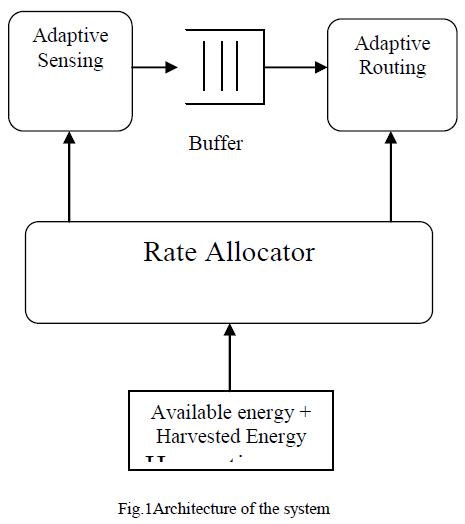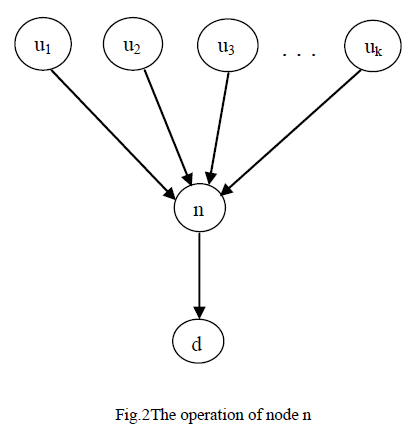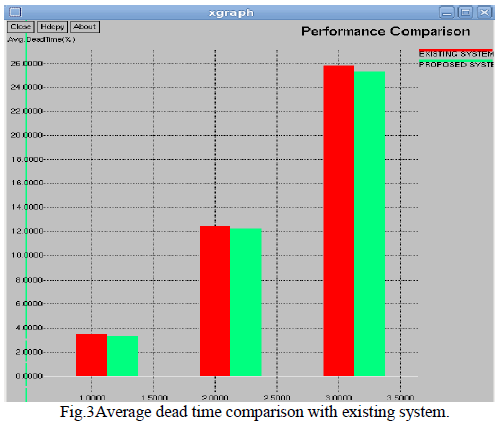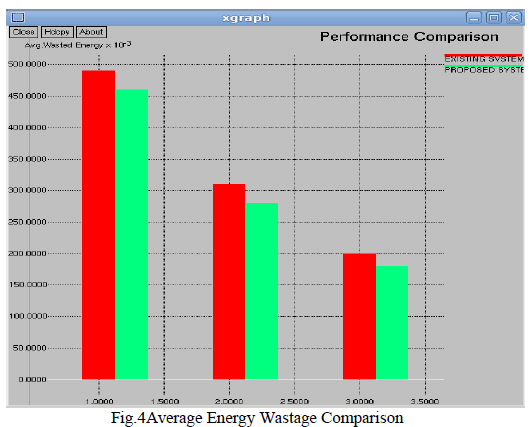Keywords
|
| Adaptive,Wireless Sensor Networks, Energy Harvesting, Fairness |
INTRODUCTION
|
| Energy harvesting and disruption tolerant networking in mobile systems are difficult to achieve. When these systems harvest energy from their environment and gather data in robust manner, they can become perpetual and self-managing, streaming data to its destination. However a number of external factors make building robust system tedious. Mobility, changes in networks, seasonality can affect network connectivity and energy harvesting. Withoutbasic parameters such as network connectivity, energy availability, it is impossible to tune power management and routing. Some of the Existing systems were focused on minimizing energy consumption rather than energy awareness and adaptation. Some other systems either use local energy adaptation techniques without considering data delivery. |
| The protocol [2] uses a movement-based heuristic. This heuristic considers that nodes in real stochastic scenarios move in a way that there is some likelihood that these nodes can meet again their past neighbors. Consequently, sending messages in a controlled way to a neighborhood of a destination increases the message delivery probability and reduces traffic on the network. [2], a DTN Routing Protocol Based on Neighborhood Contact History. It is clear that nodes with high limited resources suffer continually from storage area overflow. This problem implies discarding a large amount of messages and, eventually, the network becomes unable to deliver messages. To mitigate this problem, we intent to investigate other mechanisms to prevent future transmissions of delivered messages and for releasing space in the storage area. [3] Addresses scenarios in which either transfer duration or storage is a limited resource in the network. [3] Extends routing work to address several problems that we have observed in our real network topology. Solving DTN routing is an NP – Hard problem. Constructing balanced tree is NP –hard problem so designing a better algorithm to create a balanced tree in distributed manner and also investigate algorithms that can exploit multi-path routing to achieve better lexicographic rate assignment. |
| A node needs to adapt its energy for both sensing and routing because sensing more data than can be delivered is not useful and gathering less underutilizes systems potential. So we have proposed a distributed routing protocol which balances energy for sensing, routing its own data and routing other nodes data in an energy harvesting environment. The amount of energy harvested will vary depending on the seasonality hence energy management is an important and difficult task in mobile sensor networks. Existing systems were not considered energy as a metric for the task of routing. In this system we have considered energy availability for routing and sensing tasks. Distributed routing algorithm balances energy allocation across three tasks – sensing, routing its own data and routing other nodeâÃâ¬ÃŸs data. The process of energy allocation ensures max-min fairness. Sensing and routing are inherently dependent, optimizing one or the other in an energy constraint environment fruitless. Rate allocation is formed as a constraint optimization problem. Each node in the network measures energy consumption and harvested energy then performs rate allocation. |
APPLICATIONS AND CHALLENGES
|
| The movements and behaviors of most animal species in the wild are completely unknown. Current methods like trapping and manual radio telemetry are labor intensive, yield few data points, and significantly increase the frequency of animal interactions with humans. By using small sensor devices to observe animal movement, location, and environmental conditions, researchers will be able to collect more data at higher temporal densities with minimal impact on behavior. We can monitor the behavior of different species including human. And also for other monitoring purposes like weather forecasting, to monitor the heat level in chemical industries and so on. |
| A. Challenges |
| While designing a mobile sensor networks, number of problems have been encountered. The primary difficulty in designing mobile sensor network is the continuous variation of both energy harvesting and network connectivity due to mobility. So the devices used in such situation have to adapt its behavior over time. Energy harvesting is another problem because the quantity of energy harvested will vary according to the weather condition. Hence we have to deal with energy availability because the nodes are energy constraint and we have to protect the nodes from dead to provide high network lifetime and also we can increase overall data delivery of the system. Next problem is network connectivity. The nodes in WSN are highly mobile hence the connectivity between nodes are unpredictable. So the routing decisions in such networks must depend not only on topology, but also the energy availability. The meeting patterns are completely unknown hence achieving high data delivery in MSNs is a difficult task. |
ARCHITECTURE
|
| Architecture of the system is shown in figure 1. Adaptive sensing will collect data and the term adaptive is that the sensing rate will change based on energy, An adaptive routing is for delivering the nodes data, and the rate allocator will allocate the rate at which a node can send and receive the data from and to the neighbors. Energy harvesting is the process of collecting energy from natural resources like sunlight, vibration and etc. |
| A. Adaptive Sensing |
| Adaptive sensing system will change the sensing rate according to the energy availability of a node. Adaptive sensing is important in networks containing energy constrained node to utilize the energy effectively. For real time implementation there are number of systems available like Eon, PixieOS and Levis etc. to measure harvested energy. |
 |
| B. Adaptive Routing |
| Adaptive routing will change the sending and receiving rate of each node based on the energy availability. The routing algorithm estimates a distance metric between each node, if the node is in communication range then makes it as a neighbor, then the node having minimum distance is considered as a downstream node and the remaining nodes are considered as upstream nodes. The n is having „kâÃâ¬ÃŸ upstream nodes and „dâÃâ¬ÃŸ as a downstream node. Upstream nodes can forward its data to node d through node n. the operation of node n is shown in figure 2. The term adaptive meant that, if a node A is receiving data from the nodes B and C. the allocated rate for node B and C on node A is 5 and 9 respectively. But for a particular period of time the bone B is sending data to node A at the rate 3, then the node A will change the allocated rate for B from 5 to 3. And it can utilize the remaining for other nodes which is having more data to transfer. The changes may be due to node mobility, energy availability and connectivity among two peers. |
| C. Rate Allocation |
| Rate allocation algorithm is implemented based on two assumptions 1) a node routes packets through only one neighbor, and 2) data are forwarded not replicated. |
| Replication is the process of maintaining more than one copy of data in the network which means whenever a node receives a packet it has make a copy of it then forward the packet to corresponding node in the network. While in the process forwarding, single copy is maintained over the network. |
| Rate allocation is the process of allocating rate to each node for both sensing, receiving other nodes data and delivering other nodes data and its own data based on the energy availability. Here we have considered energy as an metric to increase the lifetime and throughput of the mobile sensor network. u1,u2,u3…,uk are upstream nodes. And d is the downstream node. Each node has to find its neighbor based on the distance between the nodes. The nodes which are in the communication range of a node are called as neighbor nodes. A node can communicate directly with its neighbors. The node which is having minimum distance is considered as downstream node and the remaining nodes in neighbor set are called as upstream nodes. Upstream nodes can forward its data to d via the node n. the upstream and downstream relationship will vary over a period of time because the nodes in the network are highly mobile and the connection among the nodes are unpredictable. |
 |
| Node n executes rate allocation algorithm in order to determine its own sensing rate rnand the rate at which it can route the data for its neighbors r1, r2, r3, … ,rk. The allocation problem is formulated as a Constraint Optimization Problem(COP). To achieve max-min fairness we are using Progressive Filling Algorithm. The objective of max-min fairness is to achieve maximum throughput with spending minimum resource. Max-min fairness objective is to collect as much data from as many nodes as possible. Locally measured values for calculation are energy required to sense the data(Es), energy required to receive the data from upstream nodes(Er),energy required to deliver the sensed and received data(Ed) including energy required to discover neighbors and protocol overhead. P is the energy available at the moment for usage. These are the parameters that are calculated on each node for further calculation. The formation of COP is given below. |
| Objective Function: The objective of the rate allocation is to achieve max-min fairness in the data collected across the nodes. A rate allocation is max-min fair if increasing any rate ri, requires the reduction of a lesser rate rj, rj ≤ ri. We can also say it as Lexicographically Maximum rate assignment which is given in (1). |
| Lexicographically max.{r1,r2,r3, … ,rn} (1) |
| Energy Conservation Constraint: A nodeâÃâ¬ÃŸs harvested energy is sufficient for all sensing and other networking tasks. Energy conservation constraint says that the sum of energy required for sensing, receiving and to deliver should be less than the remaining energy of a node. Equation (2) ensures that node n can sense and deliver at the rate rn and receive and deliver data at a rate ri from each upstream node ui without exceeding its available energy P. |
 |
| Downstream Constraint: The total data n can forward to its downstream node d should be acceptable by the node d. node n assigns a maximum rate to its upstream nodes, d likewise assigns a maximum data rate to n. Equation (3) ensures that the node n can never accept or collect data at a rate higher than the rate, O (the rate at which it can route packets through its downstream node d), at which it can deliver data. |
 |
| Upstream Constraint: The objective and above two constraints (2) and (3) alone will result in all upstream routing rates being assigned equal to the local sensing rate. This equal division of resources is fair, however, the system will underutilized if some upstream nodes are unable – due to energy limitations – to take advantage of the allocated rate. To avoid this condition, each upstream node, ui, provides node n with an additional value, Bi is the maximum amount of data that an upstream node can send, given its energy limitations which is given in Equation (4). |
 |
| The COP can be solved by using a well-known progressive filling algorithm[7].The algorithm evenly adds rate to each upstream link. As rates reach their limits, they are excluded from receiving additional rate, and the process continues until either all peers are excluded or no residual energy is available. This algorithm is fast, easy to implement, and amenable to use on low-power platforms. |
| D. Energy Harvesting |
| Energy harvesting is implemented via simulation using already available energy traces in [4]. Energy harvesting facility will increase the energy on each node. The increasing energy availability will increase the data delivery rate and reduces dead time of each node. |
| IV. EVALUATION |
| Proposed system balances sensing and routing rates to provide max-min fairness in the network with the addition of sleep mode facility. we compare the performance of proposed system with existing system. Our evaluation compares the energy and dead time parameters in the network. |
| Sleep mode in proposed system [10] will increase the network lifetime by making the node to be alive for some more time because node in sleep mode will consume less energy when compared to active mode. |
 |
| Dead time will be reduced and energy utilization will be improved in the proposed system when compared to existing system. We can make the comparisons by having three different rate levels 1) Conservative (most of the nodes in the network can afford this mode of rate), 2) Median (Half of the nodes in the network can afford the median rate), and 3) Mean (Only few percentage of nodes in the network can afford the mean rate). |
| For simulation purpose, we have deployed 100 nodes in a random topology with random movements to each node. Initially each node is having 100 Joules of energy. Energy harvesting is done in a periodic manner with the maximum values as in [5] based on the environmental condition. |
 |
| For our evaluation we have used 50 for conservative, 150 for median and 300 for mean. In fig 3 and fig 4 the plotted value of 1, 2, and 3 represents conservative, median and mean respectively. |
| Our evaluations show that the proposed system will increase the network lifetime through reducing average dead time as shown Fig 3. The proposed system will reduce the average energy wastage as shown in Fig 4 from which we can infer that the energy utilization will increase. |
CONCLUSION
|
| DRHDD has implemented a system which balances energy for sensing, routing its own data and routing data for its upstream nodes. To optimize energy we have implemented energy harvesting on each node. This system considers energy as a constraint for routing in energy harvesting mobile sensor networks and also we have included sleep mode which will increase energy utilization and reduces average dead time of a node in the network. |
FUTURE ENHANCEMENT
|
| DRHDD successfully enforces a max-min fairness policy and is suitable for use on low power sensing platforms. This work could also be extended to support other notions of fairness (e.g., proportional fairness).To allow timely or critical data to be given higher priority in the network and it will also be extended towards lifetime maximization of the network. |
References
|
- Aruna B, Jacob Sorber, Mark D.Corner, Joshua R. Ennen, and Carl Qualls (2013),”Tula: Balancing Energy for Sensing and Communication in a Perpetual Mobile System”, IEEETRANSACTIONS ON MOBILE COMPUTING, VOL 12,NO.4,APRIL2013
- ArunaBalasubramanian, B.N. Levine, and A. Venkataramani(2007), “DTN Routing as a Resource Allocation Problem,” Proc.ACMSIGCOMM.
- C. R. de Oliveira and C´ elio V. N. de Albuquerque NECTAR: A DTN Routing Protocol Based on Neighborhood Contact HistoryEtienne
- C. Schurgers and M. Srivastava(2001), “Energy Efficient Routing in Wireless Sensor Networks,” Proc. IEEE Military Comm. Conf. (MILCOM âÃâ¬ÃŸ01) Comm. for Network-Centric Operations: Creating the Information Force, vol. 1, pp. 357-361.
- http://weather.cs.umass.edu,2012
- J. Burgess, B. Gallagher, D. Jensen, and B.N. Levine(2006), “MaxProp: Routing for Vehicle-Based Disruption-Tolerant Networks,” Proc. IEEE INFOCOM.
- J.-Y. Boudec(2000), “Rate Adaptation, Congestion Control and Fairness: A Tutorial,” EcolePolytechniqueFede´rale de Lausanne (EPFL).
- L. Tassiulas and S. Sarkar(2002), “Maxmin Fair Scheduling in Wireless Networks,” Proc. IEEE INFOCOM, vol. 2, pp. 763- 772.
- S. Jain, K. Fall, and R. Patra(2004), “Routing in a Delay Tolerant Network,” Proc. ACM SIGCOMM, pp. 145-158.
- Ying J. Zhang, Feng Liu, Chi-Ying Tsui (2010), “Joint Routing and Sleep Scheduling for Lifetime Maximization of WSNs”IEEE TRANSACTIONS ON WIRELESSCOMMUNICATION,VOL 9,NO 7,JULY 2010.
|